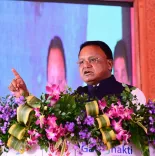Ajit Pawar: Striving for a $1 Trillion Economy Without Sacrificing Fiscal Discipline (IANS INTERVIEW)

Synopsis
Key Takeaways
- Ambitious economic goals for Maharashtra.
- Focus on fiscal responsibility despite increasing deficits.
- Plans for significant infrastructure investment.
- Innovative funding strategies to support development.
- Job creation and investment attraction policies.
Mumbai, March 11 (NationPress) Unfazed by budgetary challenges, Deputy Chief Minister Ajit Pawar has unveiled a strategic plan for Maharashtra to achieve a $1 trillion economy by fostering growth across various sectors.
In a conversation with IANS, he detailed the government's approach to meet this ambitious goal.
IANS: Are you worried about the projected increase in revenue and fiscal deficits for 2025-26?
Ajit Pawar: For the fiscal year 2025-26, the revenue deficit is projected at Rs 45,891 crore and the fiscal deficit at Rs 1,36,000 crore. However, the government has succeeded in keeping the fiscal deficit below 3 percent of the gross state domestic product (GSDP) as mandated by the Fiscal Responsibility and Budget Management Act. Additionally, the state's revenue deficit consistently remains below 1 percent of GSDP.
IANS: The state's debt is expected to reach Rs 9.32 lakh crore by 2025-26. How does this affect development spending?
Ajit Pawar: The GSDP for 2025-26 is anticipated to be Rs 49.39 lakh crore, an increase from Rs 45.31 crore in 2024-25. Tax revenue is projected to rise by 6.41 percent to Rs 4,77,400.20 crore in 2025-26, compared to Rs 4.48,630.57 crore in the revised estimates for 2024-25.
Considering this, while the state debt is expected to be Rs 9.32 lakh crore, it will constitute only 18.87 percent of the GSDP, well below the 25 percent limit set by the Fiscal Responsibility and Budget Management Act.
The government is committed to enhancing revenue to navigate these challenges. We are focused on increasing the development rate through capital expenditure aimed at energizing the development cycle. Our goal is to elevate the Mumbai Metropolitan Region's economy to $300 billion by 2030 and to $1.5 trillion by 2047. We will also strive to secure additional central funding through centrally-sponsored schemes.
IANS: Given the limitations on increasing taxes under the GST system, what steps are being taken to ensure funding availability?
Ajit Pawar: The state's Goods and Services Tax (GST) revenue is projected to grow annually by 12-14 percent. We will implement innovative strategies such as public asset monetization, securing financing from international financial institutions, and streamlining projects to guarantee a steady flow of funds for our ambitious initiatives.
IANS: To realize the $1 trillion economy goal, what infrastructure development proposals have you included in the Budget?
Ajit Pawar: We have allocated sufficient funds for highways, ports, airports, waterways, bus transport, railways, and metro systems. We aim to ensure high-quality rural roads, with considerable financial support for state and district highways.
A new housing policy is set to be announced soon, with Rs 15,000 crore earmarked for rural housing and Rs 8,100 crore for urban housing projects over the next five years. The state's annual plan has seen a remarkable 33 percent increase, with 42 percent more allocated for Scheduled Caste schemes and 40 percent for Scheduled Tribe schemes.
A high-level committee will assess and optimize ongoing programs to enhance resource utilization and propose improvements.
Moreover, the government will soon unveil a new industrial policy aimed at attracting Rs 40 lakh crore in investment and creating 50 lakh jobs in five years. Policies for MSMEs, space, circular economy, electronics, and gems and jewelry will also be introduced to draw more investment and maintain the state's leading position.
IANS: The opposition has criticized the government for not raising assistance from Rs 1,500 to Rs 2,100 for beneficiaries under the Ladki Bahin Yojana and the farm loan waiver. How do you respond?
Ajit Pawar: The Mahayuti has regained power. We have never stated that the monthly financial assistance to women beneficiaries under the Ladki Bahin Yojana would be increased immediately. We communicated during the Assembly elections that we would enhance the aid once in power. I have not specified when this increase will be announced. The announcement will come when we are ready, and then women beneficiaries will begin to receive it. I have never commented on the farm loan waiver.
(Sanjay Jog can be reached at sanjay.j@ians.in)









